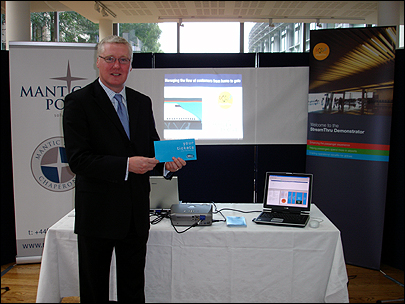World-renowned engineering firm Rolls-Royce has handed over an RFID-based airline passenger management application it developed to U.K. software company Mantic Point Solutions. The application is called StreamThru. Rolls-Royce has also made available two patents used in the system.
The StreamThru system uses passive UHF EPC RFID tags attached to boarding passes to help manage the flow of airline passengers through the airport. It also uses cellular and bar code technology.
Mantic Point says it will market the StreamThru passenger-management system, which was built on Mantic’s own Chaperone flow management application. The latter was developed with health-care and supply chain applications in mind.
Rolls-Royce has reportedly taken a 40 percent stake in Mantic, in return for turning over patents dealing with the concept of using RFID zones, or areas of RFID coverage, to track people—in this case, passengers—moving through a process. With StreamThru, passengers register their mobile phone numbers when purchasing their tickets and are given boarding passes with RFID tags attached. The goal is to create two-way communication between passengers and airline or airport operators, so as to improve the flow of passengers through the airport.
To detect passengers, RFID readers (interrogators) will be placed at key choke points, such as passport control and departure gates. The StreamThru system can then determine if a given passenger is likely to be late for his or her flight.
According to the company, it is vital that airlines know where their passengers are. “The second most common cause of flight delays [after weather] is from passengers not getting to the gate on time,” says Mike Atherton, managing director of Mantic Point.
The rise of online check-in has also added to this dilemma. In the days before online check-in became available, airlines could easily tell if passengers were at the airport once they checked in. Because passengers can now check in online, Atherton explains, airlines are sometimes left waiting for passengers who are not even in the airport. A delay at a departure gate can result in penalties from the airport operator, he says, and may harm consumers’ perception of an airline.
The StreamThru application, Mantic maintains, can not only track passengers through the airport, but also keep passengers informed by sending relevant personalized flight information to their wireless phones automatically.
StreamThru’s ability to contact passengers might also entice airport operators to deploy this technology. An operator could use the system to send marketing information and special offers to passengers—for example, if StreamThru were to detect that a passenger had not yet arrived at the airport and was late, it could send a text message offering a chargeable valet parking service. “It allows airports to target retail offers to passengers, and retail is a big revenue source for airports,” says Atherton.
Mantic says it will work with RFID and other equipment suppliers to help sell the StreamThru application as a turnkey service. So far, Mantic has not provided any pricing or RFID equipment details, but the company indicates it hopes to announce trials of the system before the end of the year.


